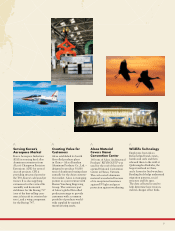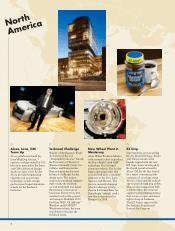Alcoa 2006 Annual Report Download - page 18
Download and view the complete annual report
Please find page 18 of the 2006 Alcoa annual report below. You can navigate through the pages in the report by either clicking on the pages listed below, or by using the keyword search tool below to find specific information within the annual report.
Commissioning
Pinjarra Upgrade
The Pinjarra efficiency
upgrade was completed in
2006, increasing the refinery’s
production capacity by about
17% and adding 657,000 mtpy
of low-cost alumina. The
upgrade is also delivering sig-
nificant environmental benefits:
energy efficiency improve-
ments, increased alumina yield
and the contribution of two
new cogeneration power
stations, which produce power
for consumers and provide
steam to the refinery.
Portland Turns 20
The Portland Aluminum
smelter, one of the most
efficient smelters in the world,
celebrated its 20th anniversary
in 2006. It has produced more
than 6 million mt of aluminum
since it began operating in
1986, and 97 of its 620
employees have been working
there since the beginning.
To mark the occasion, Alcoa
Chairman and CEO Alain
Belda presented the Portland
community with an aluminum
sculpture, “Spirit of the
Albatross,” by Western
Australian artist, Ron Gomboc.
Industry Leader
In a first for industry in
Western Australia, Alcoa vol-
untarily issued Environmental
Improvement Plans for each
of its refineries and mines. The
plans, developed with input
from local communities, set tar-
gets and actions beyond those
specified in formal licensing
and are aimed at continually
improving environmental per-
formance. Community and
government stakeholders
who helped frame the plans
will review progress toward
the goals.
Australia
16
























